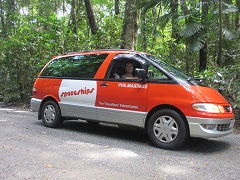Once we were finished exploring the two main cities of Australia we headed for the countries smallest state, Tasmania. With one third of the state covered by national parks it is easy to understand that the beautiful outdoors attracts visitors. After picking up our rental car we set off to explore these parks.
Our first stop was Maria island national park. Maria Island is a former prison island on the east coast of Tasmania with a very interesting geology. After taking a ship to the island we walked to a fascinating rock formation that looked at though it had been hand painted. The walk on Maria
Island also made us come face to face with wild kangaroos for the first time.
Our second park on the agenda was Freycinet. It is mainly famous for one thing, wine glass bay. The bay with it's white sand beach is as picture perfect as a beach can be. The short hike from the parking lot up to the lookout point was very crowded. Luckily most people turned back after snapping a few pictures and we could enjoy the rest of our hike without the flip flop hikers. Towards the end of the hike we saw a poisonous Australian snake for the first time.
The third and last park we visited was the most famous national park in Tasmania, Cradle Mountain. It is famous for it's beautiful mountain scenery and extensive number of excellent hiking trails. The park is located on higher altitude and like always weather can be very unpredictable when reaching these heights. Unfortunately the weather was not on our side and we could not witness the true beauty of this park.
The week in Tasmania was our first driving experience in Australia and one thing that really struck both of us was the amount of road kill. There were so many dead kangaroos, wombats and snakes. We realized that driving at night was out of the question due to the large amount of wild life in Australia.
Before leaving Tasmania we spent some time in the state capital Hobart. It is a wonderful waterfront city with a real small town feel, just like the rest of the island.




























































